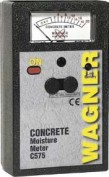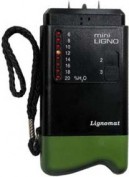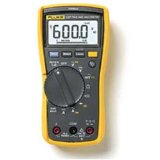Search This Site
Search With Google
The carbide meter also is affected by hygroscopic salts in materials and responds to them immediately. When you use one on a site it becomes clear that the carbide meter has big problems distinguishing between a free and hygroscopic moisture.
Materials that are heavily contaminated with salt can have moisture content levels over 5 % without any free moisture. So you can see that it is very easy to get a misreading and carry out unnecessary repairs and work.
What we really find is a big issue with the carbide meter is when you try to compare moisture content levels of different materials in order to try and diagnose the origin of a moisture problem.
Different substances have different saturation moisture contents and its not possible to make direct comparisons between different materials. People do try this with the carbide meter on site and it leads to a misdiagnosis.
Reading what you have so far, it becomes clear that we are not great admirers of the carbide meter.
As pointed out, there are many disadvantages in using one and as an on site testing tool, it can be responsible for many misdiagnosis with misinterpreted results.
Users of the carbide meter tend not to be fully trained in using the testing equipment and gaining results can be a slow process when compared with testing with a moisture meter.
It can take well over 5 minutes to get a result using the carbide meter and because of this, users tend to only take one or two samples, which is not enough in our opinion.
Its easy to criticise, but credit where credit is due. The carbide meter comes in to its own as an off site moisture tester.
For determining total moisture content, hygroscopic moisture content and free moisture content in a series of vertical samples, the carbide meter excels in a laborary method and becomes the proper diagnostic tool is was meant to be.
Carbide meter vs Moisture meter
For on site use the moisture meter is superior just as long as it is used correctly with expertise and their limitations known. They are faster to use and cleaner by not destroying a building as they are non intrusive.
The carbide meter, even when used with expertise has many shortfalls as an on site measuring instrument. They cause damage and the results are easily misinterpreted.
This can lead to unneccesary building and repair costs which can be expensive.
Off site the carbide meter excels in laboratory conditions and leaves the moisture meter way behind in its wake.
Summise
Both instruments play a totally different role and should be used accordingly. On site one should use an electrical moisture meter. Off site the carbide meter should be used for testing moisture content levels.
The Carbide Moisture Meter
On This Site



Sponsored Links
The carbide meter is an alternative solution to the moisture meter for testing and diagnosing damp problems. Comparisons can be made between the two, but as to which is a better method of testing can be of strong debate. Those that own and use a carbide meter swear by them as they do give a true quantative reslt of moisture content in a substance. One drawback, and a significant one, is that the carbide meter employs a destructive method in determining moisture content levels. It requires samples to be removed so they can be tested.
The carbide meter is mainly used as an onsight testing tool. With walls they are used to test for levels of 5% moisture content or less as this is considered to be ok and that rising damp is not affecting the wall. Problems here though are that the 5 % threshold are for the base of the wall and it is very difficult to distinguish between moisture content and humidity moisture content when you are on sight.
Moisture Meter Guide 2010 Contact details:garnett65@hotmail.com


The complete moisture meter website
Moisture Meter Guide

| Tramex Moisture Encounter Plus |
| Tramex Compact Wood Moisture Meter |
| Tramex Concrete Encounter Moisture Meter |
| Tramex Skipper Plus Moisture Meter |
| Tramex Roof And Wall Moisture Scanner |
| Sonin Digital Moisture Meter model 50218 |
| Sonin Digital Moisture Meter 270 model 50270 |
| Sonin Moisture Test Tool model 50210 |
| Sonin Moisture Test Meter Model 50211 |
| Oak |
| Douglas Fir |
| Beech Tree |
| Elm Tree |
| Hickory Tree |
| Maple Tree |
| Pine Tree |
| Prevent And Repair Gaps In Wooden Floorboards |
| How To Fix A Squeaky Hardwood Floor |
| How To Repair A Hardwood Floor That Has Buckled |
| Which Is The Best Firewood? |
| Concrete |
| Concrete Moisture |
| Screed Moisture Meter |
| SDS Drill |
| Belle Cement Mixer |
| SDS Drill Advice |
| Which SDS Drill |
| SDS Drill Accessories |
| Drilling Into Concrete |
| Kennedy Tool Box |
| Moisture - Basic Facts |
| Types Of Damp |
| Wet Rot |
| Dry Rot |
| Mold |
| Water Leak Detection |
| Stucco Moisture |
| Water Damage |
| Moisture And Rust |
| Moisture Damage To A Chimney |
| Wallpaper Stripper |
| Plaster Mixer |
| Why Worry About Moisture Problems |
| Does Your Home Have A Moisture Problem? |
| How To Solve Moisture Problems |
| How To Use Anti Mold Paint |
| Rising Damp |
| Condensation |
| Salt Damp |
| How To Avoid Bathroom Condensation |
| How To Remove Black Mold |
| How To Prevent Bathroom Mold |
| Soldering Kit |
| Soldering Kit Contents |
| Soldering Kit Advice |
| Bonsai Tree Classification |
| Growing Bonsai From Seed |
| Bonsai Tree Care |
| Bonsai Tree Training |
| Bonsai Tools |
| Displaying Bonsai |
| Bonsai Calendar |
| Bonsai Plants |
| The Thirsty Light Curve Moisture Meter |
| The Thirsty Light Ladybird Moisture Meter |
| The Thirsty Light Bumble Bee Moisture Meter |
| The Thirsty Light Butterfly Moisture Meter |
| Hanna Instruments |
| Agratronix Portable Coffee Moisture Tester |
| Lawn Aerator |
| Lawn Roller |
| Lawn Rake |
| Lawn Sand |
| Chainshot |
| Chainsaw Gloves |
| Chainsaw Trousers |
| Chainsaw Boots |
| Mac 4 - 20 XT Chainsaw |
| Mac 738 Chainsaw |
| Mac 842 Chainsaw |
| Mac 20X Power Chainsaw |
| Einhell BG-PC 3735 Chainsaw |
| Einhell BG-PC 4040 Chainsaw |
| Einhell BG-PC 5045 Chainsaw |
| Poulan P3314 Chainsaw |
| Poulan P4018 Chainsaw |
| Poulan Pro PP3816AV Chainsaw |
| Poulan Pro PP4218AVX Chainsaw |
| Poulan Pro PP4620AVX Chainsaw |
| Efco MT 4100 SP Chainsaw |
| Efco MT 3500 Chainsaw |
| Efco 132 S Chainsaw |
| Efco 147 Chainsaw |
| Efco 152 Chainsaw |
| Efco MT 7200 Chainsaw |
| Efco MT 8200 Chainsaw |
| Efco MT 3750 Chainsaw |
| Methods Of Obtaining Soil Moisture Levels |
| Hygrometer |
| Psychrometer |
| Rain Gauge |
| Wave Ventilation System |
| Humidity |
| Hygrometer For Keeping Reptiles |
| Humidor |
| Weather Stations |
| Musical Instrument Storage |